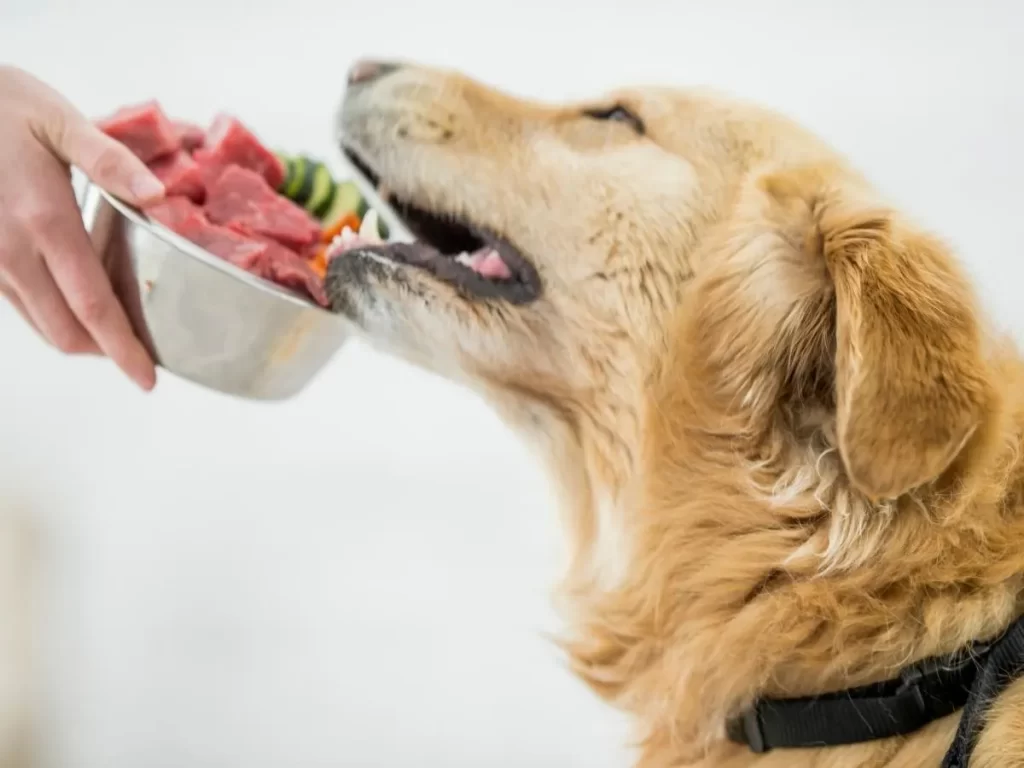In recent years, the trend of raw feeding for dogs has gained traction among pet owners seeking to provide their furry companions with a natural and wholesome diet. However, a pertinent question arises: Can I feed my dog raw meat from the supermarket? This article delves into the pros, cons, and crucial precautions associated with this practice. By understanding the nuances of raw feeding and its implications, you can make an informed decision about what’s best for your canine friend’s health.
Understanding Raw Feeding
Before delving into the specifics of feeding your dog raw supermarket meat, let’s explore the foundation of raw feeding itself. Raw feeding involves providing dogs with a diet primarily composed of uncooked and unprocessed ingredients, mirroring their ancestral eating habits. Advocates of this approach claim that it leads to improved overall health and vitality. Now, let’s focus on the key question at hand: Is raw supermarket meat a suitable choice for your dog’s raw diet journey?

Benefits of Raw Feeding
Raw feeding enthusiasts emphasize several potential benefits that come with providing dogs with a diet rich in raw meat. One of the primary advantages is the nutritional value that unprocessed meat retains. Fresh meat is a source of essential nutrients like protein, vitamins, and minerals that contribute to a dog’s overall well-being. Additionally, proponents suggest that a raw diet might lead to healthier skin and coat, improved digestion, and better weight management.
Risks and Concerns
While the benefits of raw feeding are appealing, it’s essential to address the risks and concerns associated with this practice. One of the main worries is the potential for bacterial contamination in raw meat, which can lead to foodborne illnesses in both dogs and humans. Dogs may be less susceptible to some pathogens, but there’s still a risk. Another concern is the possibility of an imbalanced diet, as providing the right balance of nutrients can be challenging. Nutritional deficiencies can have adverse effects on a dog’s health over time.
Supermarket Raw Meat vs. Specialty Sources
When it comes to sourcing raw meat for your dog’s diet, you might consider options available at your local supermarket. However, it’s crucial to make an informed choice. Raw meat from supermarkets can vary in quality and safety. While it might be more convenient, there’s a possibility that it’s not specifically intended for raw consumption. On the other hand, specialty pet food suppliers offer frozen raw diets that are formulated to meet the nutritional needs of dogs. These diets are carefully designed to provide a balanced and safe raw feeding experience.
Precautions and Best Practices
If you decide to incorporate raw meat from the supermarket into your dog’s diet, taking precautions is paramount. To ensure your dog’s safety and well-being, follow these best practices: Always opt for human-grade, high-quality meat. Properly store and handle raw meat to prevent contamination. Maintain good hygiene by cleaning feeding bowls and utensils after each meal. Additionally, consider consulting your veterinarian before making any dietary changes, as they can provide personalized guidance based on your dog’s specific needs.
Consulting a Veterinarian
Transitioning your dog to a raw diet, whether from the supermarket or elsewhere, requires careful consideration. Before embarking on this journey, consult your veterinarian. Veterinarians can offer valuable insights into your dog’s individual health needs and recommend whether raw feeding is suitable. They can also guide you through the transition process, ensuring that your dog’s nutritional requirements are met. Remember, a veterinarian’s expertise is a crucial element in making informed choices about your dog’s diet.
Transitioning to Raw Diet
Transitioning your dog to a raw diet requires a gradual approach to minimize digestive issues. Start by introducing small amounts of raw meat alongside their current diet. Over several days, gradually increase the proportion of raw meat while decreasing commercial food. Observe your dog’s response during this transition. Look for signs of improved energy, coat quality, and overall well-being. Keep in mind that individual dogs may respond differently, so be patient and adjust the transition timeline as needed.
In the journey of deciding whether to feed your dog raw meat from the supermarket, it’s essential to weigh the pros and cons carefully. While raw feeding can offer numerous benefits, it also comes with potential risks. By understanding the importance of sourcing high-quality meat, practicing proper hygiene, and seeking veterinary guidance, you can create a balanced and safe raw feeding experience for your furry companion. Remember, the health and happiness of your dog are at the heart of this decision-making process.
Addressing Common Misconceptions
Throughout discussions on raw feeding, various misconceptions might arise. One common myth is that all dogs can easily tolerate a raw diet. However, individual dogs have unique dietary needs and sensitivities. Another misconception is that a raw diet guarantees a longer lifespan for dogs. While diet plays a role in a dog’s overall health, genetics, exercise, and regular veterinary care are equally vital factors.
Monitoring Your Dog’s Health
Once your dog is on a raw diet, it’s crucial to monitor their health closely. Look for positive changes such as increased energy, a shinier coat, and improved digestion. On the other hand, if you notice any negative changes, such as gastrointestinal upset or changes in behavior, consult your veterinarian promptly. Regular check-ups and open communication with your vet will help ensure your dog’s well-being on their raw feeding journey.
Ultimately, the decision to feed your dog raw meat from the supermarket is a personal one that should consider both the benefits and potential drawbacks. Striking a balance between the nutritional advantages and associated risks is key. By staying informed, practicing responsible sourcing and handling of meat, and prioritizing your dog’s health and happiness, you can navigate the world of raw feeding with confidence.
FAQs About Feeding Raw Meat from the Supermarket to Dogs
Q: Is it safe to feed my dog raw meat from the supermarket?
A: Feeding raw supermarket meat can carry risks of bacterial contamination. Opt for human-grade, quality meat and follow hygiene precautions.
Q: What are the benefits of a raw diet for dogs?
A: A raw diet can provide essential nutrients, improve coat quality, aid digestion, and support weight management.
Q: Can I transition my dog directly to a raw diet?
A: It’s best to transition gradually to avoid digestive upset. Mix small amounts of raw meat with their current food over a few days.
Q: Are there specific meats I should avoid feeding my dog?
A: Avoid meats with high-fat content or bones that can splinter. Consult your vet for guidance on safe and balanced choices.
Q: How can I ensure the meat is safe for my dog’s consumption?
A: Choose meat labeled as human-grade, handle it with care, and store it properly to prevent contamination.
Q: Can raw feeding lead to nutritional imbalances?
A: Yes, improper raw diets can lack essential nutrients. Consult a vet or consider commercially prepared raw diets to ensure balance.
Q: Are there any health risks for dogs when consuming raw meat?
A: Raw meat can carry pathogens that may cause foodborne illnesses. Cooking meat can eliminate these risks.
Q: Is raw feeding suitable for all dog breeds and sizes?
A: Raw feeding can be adapted to various breeds, but consult your vet to determine if it’s appropriate for your dog’s specific needs.
Q: How often should I feed my dog raw meat from the supermarket?
A: Consult your vet for personalized recommendations based on your dog’s age, size, and activity level.
Q: Can I prepare homemade raw dog food using supermarket ingredients?
A: While possible, formulating a balanced diet requires expertise. Seek professional advice or consider commercially prepared options.
Q: Can puppies be fed raw meat from the supermarket?
A: Puppies have specific nutritional requirements. Consult your vet for guidance on safely incorporating raw food into your diet.
Q: What signs should I look for to ensure my dog is thriving on a raw diet?
A: Positive changes in energy levels, coat quality, and digestion can indicate that your dog is benefiting from the diet.
Q: Should I be concerned about parasites in raw meat?
A: Freezing meat before feeding can help eliminate parasites. Consult your vet for recommendations on parasite prevention.
Q: Are there alternatives to raw feeding that offer similar benefits?
A: High-quality commercial dog foods or cooked diets can provide balanced nutrition without the risks associated with raw meat.
Q: Can I feed my senior dog a raw diet?
A: Senior dogs have specific dietary needs. Consult your vet for guidance on adjusting your diet to suit your age and health condition.
Q: What supplements might be necessary for a raw-fed dog?
A: Consult a vet to determine if supplements are needed based on your dog’s diet and individual requirements.
Q: Can a raw diet improve my dog’s dental health?
A: Chewing on raw meat and bones may help clean teeth, but dental hygiene should still be maintained through regular brushing.
Q: How long does it take for a dog to adjust to a raw diet?
A: The transition period varies. Some dogs adapt quickly, while others may take a few weeks to fully adjust.
Q: Are there risks of choking on bones in a raw diet?
A: Yes, some bones can pose a choking hazard. Consult your vet to determine safe bone options for your dog.
Q: Can I feed my dog a mix of raw and commercial dog food?
A: Yes, some pet owners opt for a hybrid approach. Consult your vet to ensure a balanced combination that meets your dog’s needs.




